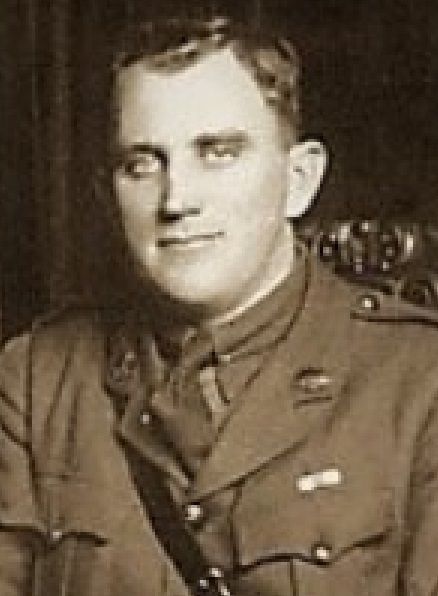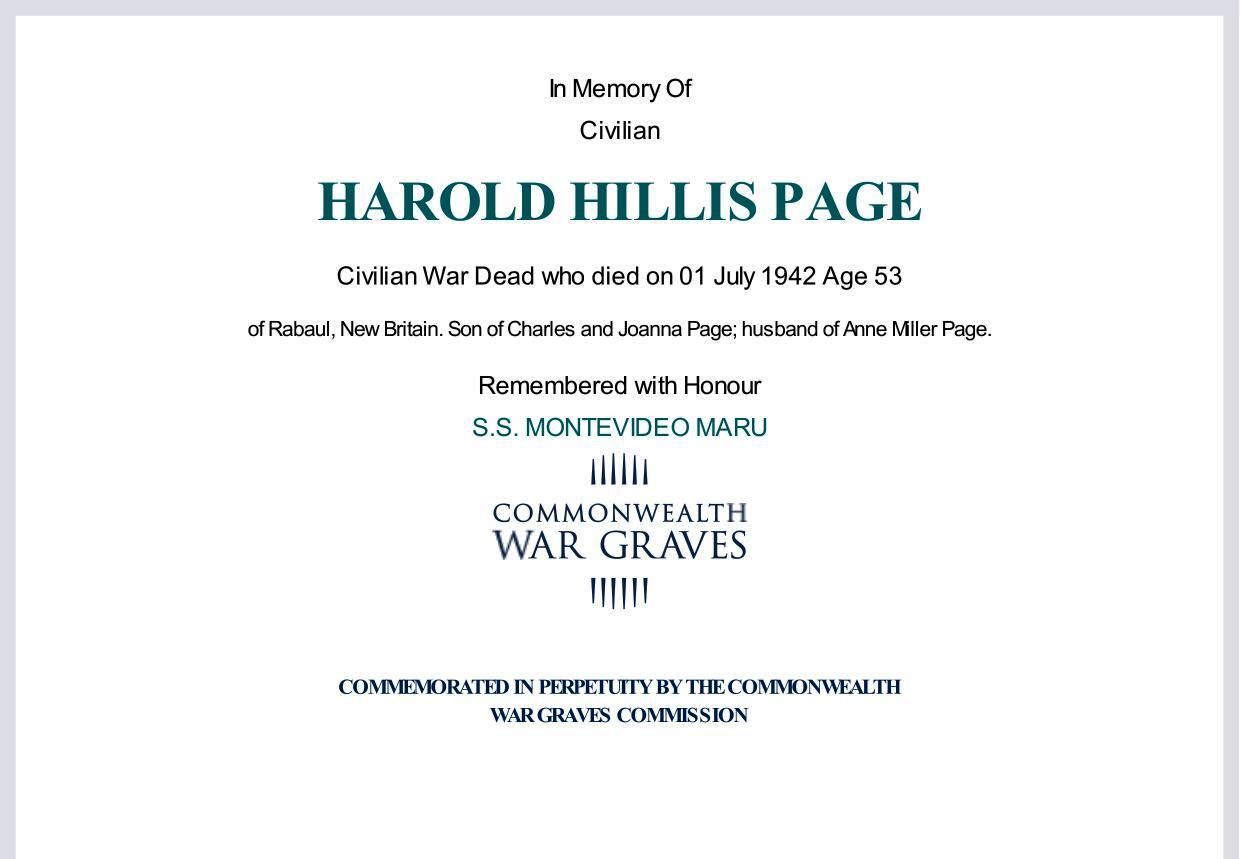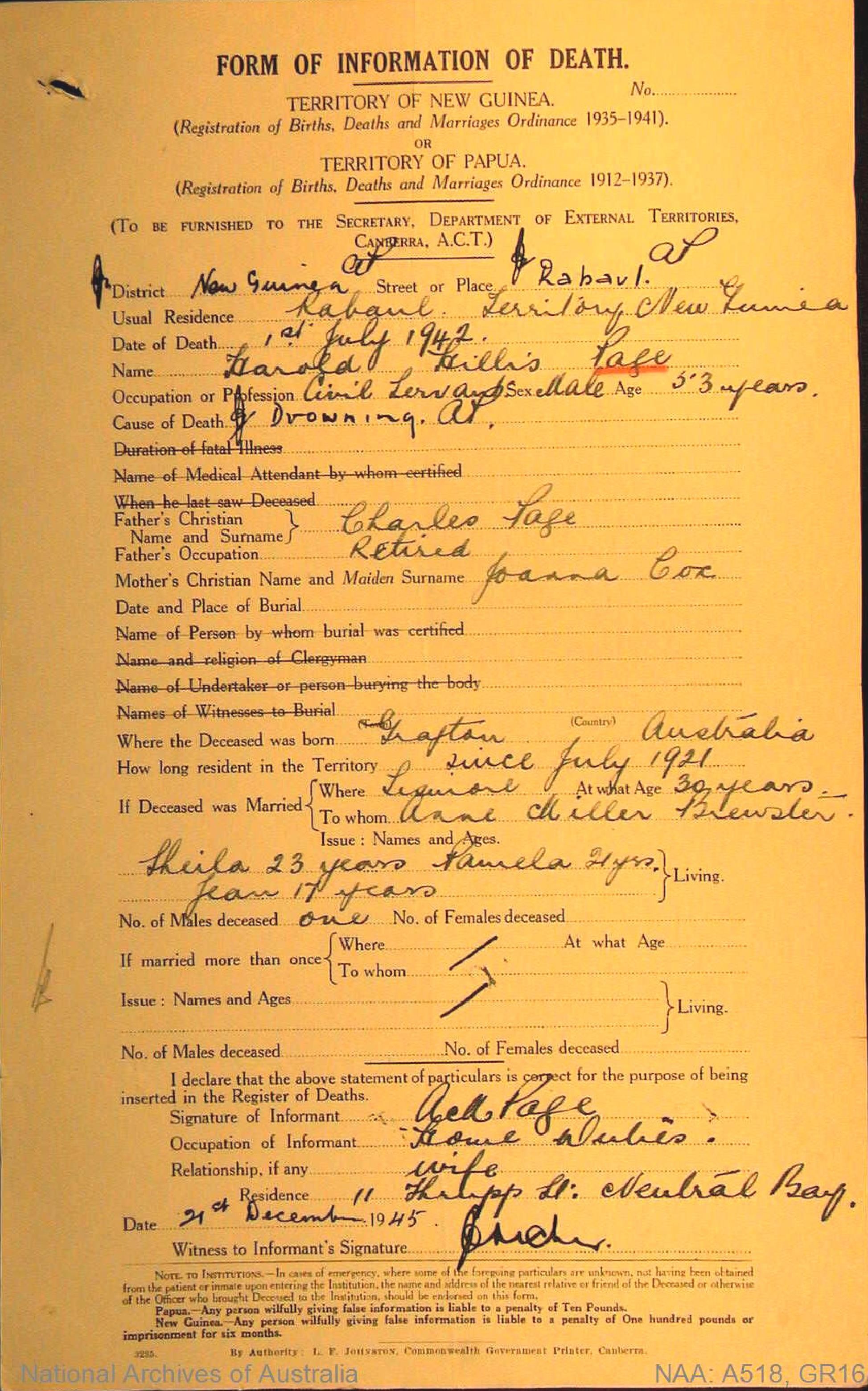Husband of Anne Miller Brewster married Lismore, NSW at age 30 years.
Page, Harold Hillis (1888–1942) by A. J. Sweeting
This article was published in Australian Dictionary of Biography, Volume 11, (MUP), 1988.
Harold Hillis Page (1888-1942), public servant and soldier, was born on 8th August 1888 at Grafton, New South Wales, eighth of eleven children of Charles Page, blacksmith and coachbuilder and his wife Mary Johanna Hadden, née Cox. (Sir) Earle Christmas Grafton and Rodger Clarence George were brothers.
Harold was educated at Grafton Public School and at Teachers' College, Sydney, in 1908-1909. He taught in the Department of Public Instruction in 1904-1913 and in 1911-1913 was a part-time arts student at the University of Sydney. In 1913 he joined the Commonwealth Public Service, working as a clerk in the Taxation Department at Lismore, then in the electoral branch, Department of Home Affairs. He enlisted in the Australian Imperial Force on 15th February 1915, was commissioned Second Lieutenant on 12th April and posted to the 25th Battalion. Promoted Lieutenant on 1st June, he embarked on 29th June and reached Egypt on 4th August.
Page arrived at Anzac on 11th September where the 25th Battalion was disposed on the left of the line on lower Cheshire Ridge. There was now little heavy fighting but the Australians made frequent excursions into no man's land. Page, fair-haired and strongly built, distinguished himself on the night of 29th October when he and Sergeant A. V. Bracher made a bold reconnaissance. They disabled two Turks, threw bombs into the Turkish trenches and gained valuable information concerning the enemy's dispositions.
In a letter to his brother, Earle in early December, a few days before his promotion to Temporary Captain, Page expressed his dissatisfaction with the conduct of the campaign. 'We are still where we were on 6th August, 1915, and still have the methods that prevailed in times of the old Greeks and other ancients in almost all departments. A washout nearly describes the situation here'. Page was wounded by shell-fire on 18th December and evacuated next day; he rejoined his unit in Egypt on 19th January 1916 and on 15th March embarked for France. He was in the trenches east of Armentières in April and on 27th May was confirmed as Captain. Active in patrolling, on 28th June he commanded a successful raiding party of seventy men at Ontario Farm near Messines. Though wounded in the spine during the approach, Page continued with great dash and was awarded the Military Cross. He was evacuated to England and after rejoining his unit on 25 November took part in trench defence at Le Transloy and Gueudecourt, thus experiencing the terrible Somme winter of 1916-1917.
Page was twice detached to Administrative Headquarters, A.I.F., London, in 1917-1918 for a total period of about six months and had charge of the general election for the whole overseas A.I.F.
Promoted Major on 26th July 1917, he took part in the attacks at Westhoek and Nonne Bosschen on 20th September and was second-in-command of the 25th Battalion in the attack through Zonnebeke and Broodseinde Ridge. Afterwards he took the battalion forward to form a defensive flank beyond Broodseinde. On 4th October he was captured briefly by a party of Germans. Mistaking them for Australians, he walked up to them and was seized. A British shell bursting close by caused the Germans to scatter and Page escaped. He temporarily commanded the battalion during February-March 1918 and after it returned to the Somme in late March remained as second-in-command until the completion of operations. On 10th June he helped to organize the attack along the Bray-Corbie road and briefly commanded advanced battalion headquarters. On 4th July he led the battalion in the attack on Hamel in which his unit was the right pivot for the operation, his skilful handling ensuring its success. On 23th August he was in command in the advance on Péronne, an operation in which his careful planning ensured negligible losses. While leading the battalion at Mont St Quentin on 2nd September, he was wounded in the abdomen; he was evacuated to England and did not rejoin his unit until just before the Armistice. He was awarded the Distinguished Service Order and Mentioned in Dispatches for service during June-September. He was also awarded to French Croix-de-Guere.
Page returned to Australia in May 1919 and on 17th July his A.I.F. appointment ended. On 5th June at St Paul's Presbyterian Church, Lismore, he married Anne Miller Brewster. He rejoined the Commonwealth Public Service and after completing his degree (B.A., 1920) joined the newly created New Guinea Administration at Rabaul. He was briefly chief of police and director of schools, then in 1923-42 was government secretary. For nine years he was senior official member of the Executive and Legislative councils, and was Deputy Administrator in December 1941–January 1942 when the transfer of headquarters from Rabaul to Lae began, while Rabaul was under threat of Japanese invasion. In mid-December Page set in motion the compulsory evacuation of women and children. On 4th January, Japanese aircraft began to attack Rabaul; these raids increased in intensity until the invasion on 23rd January. Page was captured and in June, with 207 civilians and 845 military prisoners, was shipped from Rabaul in the Montevideo Maru. The ship was torpedoed by an American submarine (USS Sturgeon)in the South China Sea on 1st July 1942 and, except for a few Japanese, all on board perished. Page was survived by his wife, a son and three daughters. The son, Robert, a captain in an Australian commando unit, was captured and executed by the Japanese in Singapore in July 1945 after attempting to repeat a daring raid on shipping in Singapore harbour in September 1943, for which he had been awarded the Distinguished Service Order.
Husband of Anne Miller Brewster married Lismore, NSW at age 30 years.
Page, Harold Hillis (1888–1942) by A. J. Sweeting
This article was published in Australian Dictionary of Biography, Volume 11, (MUP), 1988.
Harold Hillis Page (1888-1942), public servant and soldier, was born on 8th August 1888 at Grafton, New South Wales, eighth of eleven children of Charles Page, blacksmith and coachbuilder and his wife Mary Johanna Hadden, née Cox. (Sir) Earle Christmas Grafton and Rodger Clarence George were brothers.
Harold was educated at Grafton Public School and at Teachers' College, Sydney, in 1908-1909. He taught in the Department of Public Instruction in 1904-1913 and in 1911-1913 was a part-time arts student at the University of Sydney. In 1913 he joined the Commonwealth Public Service, working as a clerk in the Taxation Department at Lismore, then in the electoral branch, Department of Home Affairs. He enlisted in the Australian Imperial Force on 15th February 1915, was commissioned Second Lieutenant on 12th April and posted to the 25th Battalion. Promoted Lieutenant on 1st June, he embarked on 29th June and reached Egypt on 4th August.
Page arrived at Anzac on 11th September where the 25th Battalion was disposed on the left of the line on lower Cheshire Ridge. There was now little heavy fighting but the Australians made frequent excursions into no man's land. Page, fair-haired and strongly built, distinguished himself on the night of 29th October when he and Sergeant A. V. Bracher made a bold reconnaissance. They disabled two Turks, threw bombs into the Turkish trenches and gained valuable information concerning the enemy's dispositions.
In a letter to his brother, Earle in early December, a few days before his promotion to Temporary Captain, Page expressed his dissatisfaction with the conduct of the campaign. 'We are still where we were on 6th August, 1915, and still have the methods that prevailed in times of the old Greeks and other ancients in almost all departments. A washout nearly describes the situation here'. Page was wounded by shell-fire on 18th December and evacuated next day; he rejoined his unit in Egypt on 19th January 1916 and on 15th March embarked for France. He was in the trenches east of Armentières in April and on 27th May was confirmed as Captain. Active in patrolling, on 28th June he commanded a successful raiding party of seventy men at Ontario Farm near Messines. Though wounded in the spine during the approach, Page continued with great dash and was awarded the Military Cross. He was evacuated to England and after rejoining his unit on 25 November took part in trench defence at Le Transloy and Gueudecourt, thus experiencing the terrible Somme winter of 1916-1917.
Page was twice detached to Administrative Headquarters, A.I.F., London, in 1917-1918 for a total period of about six months and had charge of the general election for the whole overseas A.I.F.
Promoted Major on 26th July 1917, he took part in the attacks at Westhoek and Nonne Bosschen on 20th September and was second-in-command of the 25th Battalion in the attack through Zonnebeke and Broodseinde Ridge. Afterwards he took the battalion forward to form a defensive flank beyond Broodseinde. On 4th October he was captured briefly by a party of Germans. Mistaking them for Australians, he walked up to them and was seized. A British shell bursting close by caused the Germans to scatter and Page escaped. He temporarily commanded the battalion during February-March 1918 and after it returned to the Somme in late March remained as second-in-command until the completion of operations. On 10th June he helped to organize the attack along the Bray-Corbie road and briefly commanded advanced battalion headquarters. On 4th July he led the battalion in the attack on Hamel in which his unit was the right pivot for the operation, his skilful handling ensuring its success. On 23th August he was in command in the advance on Péronne, an operation in which his careful planning ensured negligible losses. While leading the battalion at Mont St Quentin on 2nd September, he was wounded in the abdomen; he was evacuated to England and did not rejoin his unit until just before the Armistice. He was awarded the Distinguished Service Order and Mentioned in Dispatches for service during June-September. He was also awarded to French Croix-de-Guere.
Page returned to Australia in May 1919 and on 17th July his A.I.F. appointment ended. On 5th June at St Paul's Presbyterian Church, Lismore, he married Anne Miller Brewster. He rejoined the Commonwealth Public Service and after completing his degree (B.A., 1920) joined the newly created New Guinea Administration at Rabaul. He was briefly chief of police and director of schools, then in 1923-42 was government secretary. For nine years he was senior official member of the Executive and Legislative councils, and was Deputy Administrator in December 1941–January 1942 when the transfer of headquarters from Rabaul to Lae began, while Rabaul was under threat of Japanese invasion. In mid-December Page set in motion the compulsory evacuation of women and children. On 4th January, Japanese aircraft began to attack Rabaul; these raids increased in intensity until the invasion on 23rd January. Page was captured and in June, with 207 civilians and 845 military prisoners, was shipped from Rabaul in the Montevideo Maru. The ship was torpedoed by an American submarine (USS Sturgeon)in the South China Sea on 1st July 1942 and, except for a few Japanese, all on board perished. Page was survived by his wife, a son and three daughters. The son, Robert, a captain in an Australian commando unit, was captured and executed by the Japanese in Singapore in July 1945 after attempting to repeat a daring raid on shipping in Singapore harbour in September 1943, for which he had been awarded the Distinguished Service Order.
Gravesite Details
Drowned at Sea whilst when that ship was torpedoed and sunk by the American submarine Sturgeon (SS-187), about 65 miles west off Cape Bojeador, Luzon, 18 37N, 119 29E.
Family Members
Sponsored by Ancestry
Advertisement
Explore more
Sponsored by Ancestry
Advertisement












